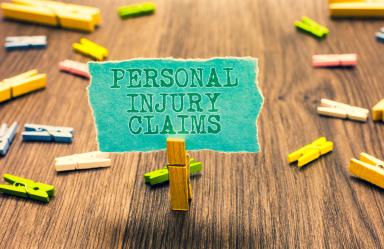South Dakota Personal Injury Laws

Accidental injuries and deaths happen at a relatively common rate throughout South Dakota. The state’s Department of Health found that from 2012 to 2021, there were 7,084 injury-related fatalities in total that occurred. Fatal injuries in 2021 were considerably higher at 46% compared to 2012, translating into the highest rate recorded thus far at 95.4 fatal injuries per 100,000 people. Additionally, the state recorded more than 229,000 non-fatal injuries between 2017 and 2021, 91% of which were unintentional. Common causes include vehicle crashes, slips and falls, and drug poisoning.
To curb further instances of injuries and deaths, government agencies and groups in South Dakota implement programs meant to preserve the safety of state residents and establish awareness of injury prevention. The undertakings include initiatives launched by the DOH and the South Dakota EMS for Children, as well as organizations such as the Safety Village of South Dakota.
In addition to the efforts, the state has a selection of legal guidelines and statutes that help South Dakotans pursue compensation for their losses through a claim or lawsuit in case they suffer an accidental injury. This article aims to deliver essential information concerning these laws, which cover relevant details such as insurance requirements, statutory limitations, comparative negligence, and case-specific damage caps.
Motor Vehicle Accident Laws in South Dakota
Motor vehicle crashes and collisions are some of the most common cases in the field of personal injury. According to South Dakota law, motorists are required to report an accident that involves any of the following:
A person’s injury or death;
Property damage worth at least $1,000 to a single person;
Property damage worth at least $2,000 in total;
Damage to an unattended property wherein the owner could not be identified;
Damage to a parked vehicle wherein the owner could not be immediately notified.
Because of the potential losses involved in these incidents, South Dakota requires motorists to obtain liability coverage to prove that they are financially capable of addressing any damages if they cause a crash. Under state law, the minimum amounts required for liability coverage follow the 25/50/25 format, which translates into:
$25,000 for the bodily injuries or death of one person;
$50,000 for the bodily injuries or deaths of multiple people;
$25,000 for any property damage.
Motorists can also use uninsured and underinsured motorist coverages if they get into an accident. These policies are often offered alongside liability coverage, and they pay for the insurance owner’s losses in case the at-fault driver in a crash has no insurance or does not have enough coverage to pay for their damages. However, both UM and UIM coverages address only losses related to bodily injuries.
Other types of applicable policies in motor vehicle accidents include:
MedPay coverage, which pays for the insurance owner’s medical treatments regardless of who caused the accident;
Collision coverage, which pays for repairs and replacements concerning the insurance owner’s vehicle;
Comprehensive coverage, which pays for any damage caused by non-collision factors such as theft, vandalism, or falling objects.
South Dakota Medical Malpractice Guidelines
Medical malpractice cases are incidents where a patient suffers harm due to the error and negligence of a doctor or healthcare provider. They can involve mistakes in surgical procedures, medication prescriptions, and anesthetic processes, along with misdiagnosed illnesses, premature discharges, and improper aftercare.
It should be noted that while medical malpractice cases in South Dakota follow a statute of limitations lasting up to two years, the discovery rule can affect this legal deadline. Under such principle, if a victim only finds out about an injury caused by the malpractice of a doctor or practitioner at a later time, the statute of limitations will instead begin counting down on the date when they have discovered or should have reasonably discovered the injury in question.
If a medical malpractice case proceeds into a lawsuit, South Dakota courts can allow a qualified medical expert to testify. This can take place if:
The expert possesses knowledge that can help the trier of fact in evaluating the evidence presented in the case;
The expert’s testimony is supported by sufficient data and facts;
The expert’s testimony is formed through the use of reliable methods and principles;
The expert has applied such methods and principles to the facts involved in the case.
Often, an expert will testify whether or not the defendant in the malpractice case followed the medical standard of care when administering the treatment that resulted in the victim’s injury or death. As such, the expert is usually another doctor or healthcare provider working in the same field as the defendant.
South Dakota’s Product Liability Laws
In the area of personal injury, product liability refers to cases where a consumer suffers an injury after using a defective product. In these scenarios, the victim can pursue compensation from the company that designed and manufactured the product in question. In South Dakota, any wholesalers or retailers that distributed or sold a defective product are generally immune from strict liability provided they were unaware of the product’s defect.
In a product liability case, the victim must prove that the product that caused their injury was inherently flawed and thus became unreasonably dangerous due to a defect in its design or manufacturing process. Additionally, they can prove whether a manufacturer, distributor, or wholesaler failed to put enough information or warning labels to notify consumers about a product’s intended use or potential dangers.
South Dakota’s Slight/Gross Comparative Negligence Rule
South Dakota courts follow a special rule involving “slight” and “gross” comparative negligence when deciding on verdicts in personal injury lawsuits or claims. According to this legal principle, a plaintiff who is partially to blame for an incident that caused their injury can still pursue and recover compensation provided that their fault is “slight” compared to the defendant’s. If a plaintiff’s fault falls under this category, their total damages will be deducted in proportion to their liability. On the other hand, plaintiffs will be barred from recovering damages if their fault is considered “gross” or great.
South Dakota’s unique negligence rule is similar to the principle of modified comparative negligence that is followed in certain states, where a plaintiff can recover damages as long as the percentage of their fault does not reach or exceed a given limit. Unlike in these states, however, where modified comparative negligence often follows a liability threshold of 50 to 51%, no definitions explicitly specify what is considered “slight” or “gross” negligence in South Dakota.
Joint and Several Liability in South Dakota
If there are multiple defendants in a personal injury case in South Dakota, the rule of joint and several liability will apply with certain differences based on the percentage of each defendant’s apportioned fault. If their fault reaches or exceeds 50%, they will be jointly and severally liable for the total amount of the victim’s damages. If their fault is lower than 50%, they will still be jointly and severally liable, but they will only be liable to pay damages that are no more than twice the amount of their proportionate share based on their fault.
South Dakota Business Liability Insurance Requirements
No law currently requires companies and establishments in South Dakota to have business liability insurance, though it is still highly encouraged. This type of policy can be used by business owners in case an individual suffers an injury at their establishment or due to the negligent actions of one of their employees. It covers costs related to the person’s medical treatment and damaged property, as well as similar damages to their character in case slander and libel are involved.
In terms of coverage amounts, smaller businesses are encouraged to obtain liability coverage worth between $500,000 and $1 million. However, if a person owns a high-risk business or one that involves frequent interaction with customers, higher policy coverage may be ideal. To determine how much liability coverage a business owner should get, they can refer to the number of employees they have, the type of goods or services they offer, and the level of their engagement with consumers.
In addition to business liability insurance, South Dakota’s government urges businesses to have workers’ compensation insurance. This policy is also not required by the state, but it does allow business owners to protect their finances by addressing any expenditures related to an employee’s medical and disability benefits in case they suffer an injury through an accident or hazard at work. Its coverage is funded through the South Dakota Workers’ Compensation Program.
Lastly, because South Dakota requires motorists to show proof of financial responsibility through insurance coverage, business owners who use vehicles to transport goods or carry out their services must get commercial auto insurance. Such a policy differs from personal auto insurance, which does not always cover vehicles used for business purposes.
How Much Can Someone Sue for an Injury in South Dakota?
Currently, South Dakota only has a cap of $500,000 on the total non-economic damages plaintiffs can recover in medical malpractice cases. These damages are caused by intangible factors stemming directly from the victim’s injury, including pain and suffering, emotional distress, and loss of companionship.
In other personal injury cases, however, South Dakota does not impose any statutory caps on both economic and non-economic damages, allowing plaintiffs to be potentially compensated in full for their losses. The type of monetary damages that a victim can recover may include past and future medical expenditures, as well as loss of earning capacity, repair costs for damaged property, and service fees in case they cannot accomplish daily tasks due to their injury.
There are also cases wherein South Dakota courts will award punitive damages to a plaintiff. This occurs mainly to punish the defendant in a case for showing gross negligence, intentionally disregarding the safety of others, or acting with wanton, willful, or malicious conduct. Like with economic and non-economic damages in most cases, there are no limitations to the amount of punitive damages a victim can receive in the state.
The Statute of Limitations in South Dakota
The civil statute of limitations for most personal injury claims in South Dakota is three years, starting from the date when the victim suffered their injury. The same three-year deadline applies in cases that result in a person’s wrongful death, beginning from the date of the individual’s passing. Any plaintiff who fails to file a suit within this given time will most likely have their claim dismissed by the court.
Other personal injury cases can result in different deadlines. For example, in medical malpractice cases and those that involve the injury of a person’s reputation through slander or libel, the statute of limitations lasts for two years. If a case results only in damage to a person’s property, the deadline is six years. Lastly, if a person wishes to file a claim against the state or local government for an incident caused by the negligence of an agency or employee, they have one year to do so.
Exceptions and Extensions to South Dakota’s Statute of Limitations
There are possible scenarios wherein South Dakota’s statute of limitations starts at a different time or is extended due to legal disabilities. For instance, state law dictates that if the person entitled to file a suit is under 18 or deemed mentally incapacitated, the period of their disability may not be counted as part of the statute’s duration. If two or more disabilities are present, the statute will not take effect until all of them are removed. However, the statute cannot be extended beyond five years in any case except infancy, nor can it be prolonged beyond one year after the individual’s disability has ceased.
Similar changes can apply if a cause for legal action accrues against a defendant who is absent from the state, in which case the statute of limitations will only begin upon their return. Additionally, if the defendant in a case leaves the state before any lawsuit or claim can be filed against them, the statute will not take the duration of their absence into account.
Legal Resources for Injured Folks in South Dakota
State Bar of South Dakota
The State Bar of South Dakota website is open to those with legal queries and concerns. It has a Lawyer Referral Service that people can access to find and contact specific lawyers who can assist them in various cases, including personal injury. Its Access To Justice section provides information on how to apply for and secure low-cost legal aid for individuals who do not qualify for pro bono representation. Additionally, those who wish to file a complaint involving ethical misconduct and other similar issues against an attorney may do so through the Lawyer Discipline section. Lastly, the organization’s Court Information section offers details on the functions, contact details, and backgrounds of various courts throughout South Dakota.
South Dakota Department of Health - Injury Prevention Resources
As part of its efforts to preserve the safety of state residents, the South Dakota Department of Health offers access to different resources related to injury prevention on its website. These include informational articles covering traumatic brain injuries, adult falls, and car safety. The website also has links to the initiatives and informative sections of agencies that contribute to spreading awareness regarding injury prevention across the country, such as the National Highway Traffic Safety Administration and the Centers for Disease Control and Prevention.
The Brain Injury Alliance of South Dakota
The Brain Injury Alliance of South Dakota is a nonprofit organization that helps brain injury survivors and their families obtain proper rehabilitative care by connecting them to services that match their needs. Its members also participate in statewide initiatives that focus on improving existing injury services to make them more accessible to individuals in need. In addition, they can help survivors from areas such as Sioux Falls and Aberdeen find injury support groups that spread awareness regarding brain-related trauma and contribute to their recovery through monthly meetings and counseling.
South Dakota Department of Public Safety - Accident Records
People involved in motor vehicle crashes requiring copies of their accident reports can purchase them through the South Dakota Department of Public Safety’s website. The department compiles reports of any crash that results in injuries or deaths, as well as property damage worth at least $1,000 to a single person or $2,000 in total. Those who wish to obtain a copy must provide information concerning the date and location of the crash in question, as well as the driver's last name. They must also pay $4 to have the report located and a $6 convenience fee for its purchase. Any new reports will not be released for three days to allow crash victims to exercise their rights under Marsy’s Law.
Expertise.com StaffAuthor
Step into the world of Expertise.com, your go-to hub for credible insights. We don't take accuracy lightly around here. Our squad of expert reviewers, each a maestro in their field, has given the green light to every single article you'll find. From rigorous fact-checking to meticulous evaluations of service providers, we've got it all covered. So feel free to dive in and explore. The information you'll uncover has been stamped with the seal of approval by our top-notch experts.




